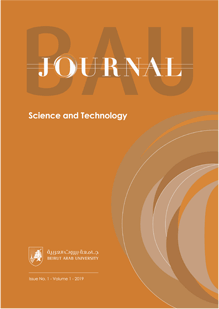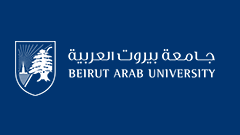BAU Journal - Science and Technology is an international academic journal published by Beirut Arab University Press. The journal hosts articles from different interdisciplinary research areas.
All published articles are peer reviewed by national and international well-recognized referees in their domains or faculty members from reputable universities around the world.
The editorial board aims that this journal will serve as a useful source of data for the scientific community and researchers around the world. In this regard, the editorial board is pleased to receive your valuable suggestions and feedback for improving the journal.
The editorial board expresses sincerest gratitude to all contributors and targeting the BAU Journal - Science and Technology to be a marquee journal in the field of sciences and technology.
Editor-in-Chief Adel El Kordi Dean, Faculty of Engineering, Beirut Arab University, Lebanon
Co Editor-in-Chief Ghassan Younes Dean, Faculty of Science, Beirut Arab University, Lebanon
Current Issue: Volume 6, Issue 2 (2025)
Prof. Roland Habchi - Lebanese University, Faculty of Sciences, Fanar, Lebanon
In this edition, we are proud to present a rich and multidisciplinary collection of research papers that exemplify both scientific rigor and creative inquiry. The issue opens with an insightful contribution on the use of artificial intelligence to enhance the effectiveness and precision of forensic audits, marking a significant step forward in modern accounting practices. In the realm of sustainable agriculture and health, two studies shed light on the powerful potential of plant-based solutions: Arum palaestinum extracts are investigated as an eco-friendly approach to nematode control, while Micromeria barbata demonstrates promising antimicrobial activity, supported by molecular docking and in vitro analysis. Environmental research is also well represented, with a case study on afforestation in the Rashaya District revealing notable improvements in soil quality and organic carbon levels, and another paper offering a risk management framework tailored to the complexities of public works projects in developing countries like Lebanon. The technological frontier is explored through an innovative federated learning model for real-time traffic event detection via social networks, as well as a critical assessment of how video distribution systems may impact satellite signal reception. Material science and engineering are addressed through multiscale modeling of heat and moisture transfer in hemp wool, contributing to sustainable construction, and a comprehensive review of the unconventional yet effective roles of salt and sugar as natural admixtures in concrete. The issue concludes with a mathematically rigorous study on the exponential decay behavior of truncated porous elastic models, reaffirming the value of theoretical approaches in advancing applied sciences. Together, these contributions not only reflect the diversity and dynamism of today’s research landscape but also reinforce the importance of interdisciplinary collaboration.
We extend our sincere thanks to all the authors for their dedication and outstanding efforts, which have greatly enriched this edition.
Articles
EXPONENTIAL DECAY FOR THE TRUNCATED VERSION OF THE POROUS-ELASTIC MODEL
Dilberto Da Silva Almeida Júnior, Baowei Feng, and Luiz Gutemberg Miranda
ARUM PALAESTINUM EXTRACTS: A NATURAL SOLUTION FOR ROOT-KNOT NEMATODE CONTROL
Samaher Ghaith, Michel Afram, and Jamilah Borjac
PHYTOCHEMICAL ANALYSIS AND ANTIMICROBIAL ACTIVITY OF MICROMERIA BARBATA LEAF AND STEM EXTRACTS AGAINST PSEUDOMONAS AERUGINOSA: INSIGHTS FROM MOLECULAR DOCKING AND IN VITRO ASSAYS
Shiraz Rawas, Dalia El-Badan, and Nawal AL Hakawati
ASSESSING THE INFLUENCE OF AFFORESTATION ON SOIL QUALITY AND SOIL ORGANIC CARBON: A CASE STUDY IN RASHAYA DISTRICT, LEBANON
Mohammad Saleh, Wael Mostafa, Safaa Baydoun, Hisham Salman, and Jamilah Borjac
FEDEVD: A FEDERATED ROAD TRAFFIC EVENT DETECTOR FROM SOCIAL NETWORKS
Ahmad Traboulsi, May Itani, Layal Abu Daher, and Ali Haidar
MULTISCALE MODELLING OF HEAT AND MASS TRANSFER IN HEMP WOOLS
Rayan El Sawalhi, Marwan Al kheir, Louay El Soufi, and Hassan Assoum
DEVELOPMENT OF A RISK MANAGEMENT SYSTEM FOR PUBLIC WORKS PROJECTS IN DEVELOPING COUNTRIES: A CASE STUDY OF LEBANON
Olivia Kalakesh, Walid Shatila, and ali Hatoum
A REVIEW ON THE USE OF SALT AND SUGAR AS NATURAL ADMIXTURES IN CONCRETE
Noura A. Yassine, Lelian W. ElKhatib, Adel Elkordi, Mohammed Sonebi, and Jamal Khatib
IMPACT ASSESSMENT OF MULTIPOINT VIDEO DISTRIBUTION SYSTEMS ON SATELLITE SIGNAL RECEPTION
Ali Karaki, Hiba Abdallah, Mohammed Al-Husseini, and Hamza Issa
FORENSIC AUDIT: ENHANCING CERTIFIED PUBLIC ACCOUNTANT USING ARTIFICIAL INTELLIGENCE TECHNIQUES
Hasan Mazloum, Nawaf Mazloum, and Ahmad Mohamad Saleh


